Response of Fuel Characteristics, Potential Fire Behavior, and Understory Vegetation Diversity to Thinning in Platycladus orientalis Forest in Beijing, China
Abstract
:1. Introduction
2. Materials and Methods
2.1. Study Areas
2.2. Experimental Design
2.3. Fuel Investigation and Sampling
2.3.1. Surface Fuel Investigation
2.3.2. Crown Fuel Investigation
2.4. Potential Fire Behavior Modelling
2.5. Understory Vegetation Diversity Investigation and Analysis
2.6. Statistical Analysis
3. Results
3.1. Variations in Surface Fuel and Canopy Fuel Characteristics under Different Thinning Intensities
3.2. Variations in Potential Fire Behavior under Different Thinning Intensities
3.2.1. Variations in Potential Surface Fire Behavior under Different Thinning Intensities
3.2.2. Variations in Potential Canopy Fire Behavior under Different Thinning Intensities
3.2.3. Fire Type under Different Thinning Intensities
3.3. Understory Vegetation Biodiversity under Different Thinning Intensities
4. Discussion
4.1. Fuel Variable Response
4.2. Potential Surface Fire Behavior Response
4.3. Potential Crown Fire Behavior Response
4.4. Understory Vegetation Biodiversity Response
4.5. Fuel Management Implications
5. Conclusions
Supplementary Materials
Author Contributions
Funding
Data Availability Statement
Acknowledgments
Conflicts of Interest
Abbreviations
| CBD | canopy bulk density |
| CFL | canopy fuel load |
| DBH | diameter at breast height |
| CK | control treatment |
| LT | light thinning |
| MT | moderate thinning |
| HT | heavy thinning |
| CF | the correction coefficient |
| AIC | Akaike information index |
| MSE | mean squared error |
| TR | transition ratio |
| AR | active ratio |
References
- Tang, X.; Machimura, T.; Li, J.; Yu, H.; Liu, W. Evaluating seasonal wildfire susceptibility and wildfire threats to local ecosystems in the largest forested area of China. Earth’s Future 2022, 10, e2021EF002199. [Google Scholar] [CrossRef]
- Zhao, F.; Liu, Y. Important meteorological predictors for long-range wildfires in China. For. Ecol. Manag. 2021, 499, 119638. [Google Scholar] [CrossRef]
- Xie, L.; Zhang, R.; Zhan, J.; Li, S.; Shama, A.; Zhan, R.; Wu, R. Wildfire risk assessment in Liangshan Prefecture, China based on an integration machine learning algorithm. Remote Sens. 2022, 14, 4592. [Google Scholar] [CrossRef]
- Tian, X.; Shu, L.; Zhao, F.; Wang, M. Impacts of climate change on forest fire danger in China. Sci. Silvae Sin. 2017, 53, 159–169. [Google Scholar]
- Jin, Y.; Zhao, W.; Nie, S.; Liu, S.S.; El-Kassaby, Y.A.; Wang, X.R.; Mao, J.F. Genome-wide variant identification and high-density genetic map construction using RADseq for Platycladus orientalis (Cupressaceae). G3: Genes Genomes Genet. 2019, 9, 3663–3672. [Google Scholar] [CrossRef] [PubMed]
- He, L.L.; Zhang, X.; Wang, X.X.; Ullah, H.; Liu, Y.D.; Duan, J. Tree Crown Affects Biomass Allocation and Its Response to Site Conditions and the Density of Platycladus orientalis Linnaeus Plantation. Forests 2023, 14, 2433. [Google Scholar] [CrossRef]
- Zhang, L.; Qi, S.; Li, P.; Zhou, P. Influence of stand and environmental factors on forest productivity of Platycladus orientalis plantations in Beijing’s mountainous areas. Ecol. Indic. 2024, 158, 111385. [Google Scholar] [CrossRef]
- Niu, S.K. Fire Behavior and Fuel Spatial Continuity of Major Forest Types in the Mountainous Area, Beijing. Ph.D. Thesis, Beijing Forestry University, Beijing, China, 2012. [Google Scholar]
- Burton, J.E.; Cawson, J.G.; Filkov, A.I.; Penman, T.D. Fine fuel changes due to timber harvesting and frequent prescribed burning in eucalypt forests of southeastern Australia. For. Ecol. Manag. 2022, 520, 120353. [Google Scholar] [CrossRef]
- Vilà-Vilardell, L.; De Cáceres, M.; Piqué, M.; Casals, P. Prescribed fire after thinning increased resistance of sub-Mediterranean pine forests to drought events and wildfires. For. Ecol. Manag. 2023, 527, 120602. [Google Scholar] [CrossRef]
- Arellano-Pérez, S.; Castedo-Dorado, F.; álvarez-González, J.G.; Alonso-Rego, C.; Vega, J.A.; Ruiz-González, A.D. Mid-term effects of a thin-only treatment on fuel complex, potential fire behaviour and severity and post-fire soil erosion protection in fast-growing pine plantations. For. Ecol. Manag. 2020, 460, 117895. [Google Scholar] [CrossRef]
- Weston, C.J.; Di Stefano, J.; Hislop, S.; Volkova, L. Effect of recent fuel reduction treatments on wildfire severity in southeast Australian Eucalyptus sieberi forests. For. Ecol. Manag. 2022, 505, 119924. [Google Scholar] [CrossRef]
- Prichard, S.J.; Hessburg, P.F.; Hagmann, R.K.; Povak, N.A.; Dobrowski, S.Z.; Hurteau, M.D.; Khatri-Chhetri, P. Adapting western North American forests to climate change and wildfires: Ten common questions. Ecol. Appl. 2021, 31, e02433. [Google Scholar] [CrossRef] [PubMed]
- Alcasena, F.J.; Ager, A.A.; Salis, M.; Day, M.A.; Vega-Garcia, C. Optimizing prescribed fire allocation for managing fire risk in central Catalonia. Sci. Total Environ. 2018, 621, 872–885. [Google Scholar] [CrossRef]
- Gao, M.; Ren, Y.M.; Zhou, X.D.; Chen, S.F.; Gao, Y.; Wang, H.Y.; Gu, Z.; Liu, X.D. Effects of thinning on canopy characteristics and potential crown fire behavior of Platycladus orientalis in Xishan Forest Farm. J. Beijing For. Univ. 2022, 44, 56–65. [Google Scholar] [CrossRef]
- Li, W.K.; Zhang, C.; Gu, X.H.; Niu, S.K.; Yin, J.Y.; Liu, X.D. Impact assessment of fuel regulation measures in Platycladus orientalis forest in Western Hills of Beijing. J. Zhejiang Agric. For. Univ. 2020, 37, 8. [Google Scholar] [CrossRef]
- Han, M. Impact of Forest Tending on Platycladus orientalis Surface Fuel Load and Potential Fire Behavior in Beijing Area. Master’s Thesis, Beijing Forestry University, Beijing, China, 2019. [Google Scholar] [CrossRef]
- Zhu, M.; Liu, X.D.; Li, X.H.; Han, X.; Ren, Y.M.; Wang, Q.F. Evaluation on the effect of fuel regulation on Pinus tabulaeformis forest in Xishan Mountain of Beijing. Acta Ecol. Sinica. 2015, 35, 4483–4491. [Google Scholar] [CrossRef]
- Duan, Z.; Ma, L.Y.; Jia, L.M.; Jia, Z.K.; Gong, N.N.; Che, W.R. Effects of thinning on growth of Platycladus orientalis plantation and understory vegetation. Acta Ecol. Sin. 2010, 30, 1431–1441. [Google Scholar]
- Schmidt, D.A.; Taylor, A.H.; Skinner, C.N. The influence of fuels treatment and landscape ar-rangement on simulated fire behavior, Southern Cascade range, California. For. Ecol. Manag. 2008, 255, 3170–3184. [Google Scholar] [CrossRef]
- Johnston, J.D.; Olszewski, J.H.; Miller, B.A.; Schmidt, M.R.; Vernon, M.J.; Ellsworth, L.M. Mechanical thinning without prescribed fire moderates wildfire behavior in an Eastern Oregon, USA ponderosa pine forest. For. Ecol. Manag. 2021, 501, 119674. [Google Scholar] [CrossRef]
- Castedo-Dorado, F.; Gómez-Vázquez, I.; Fernandes, P.M.; Crecente-Campo, F. Shrub fuel characteristics estimated from overstory variables in NW Spain pine stands. For. Ecol. Manag. 2012, 275, 130–141. [Google Scholar] [CrossRef]
- Martorano, C.A.; Kane, J.M.; Engber, E.A.; Gibson, J. Long-term fuel and understorey vegetation response to fuel treatments in oak and chaparral stands of northern California. Appl. Veg. Sci. 2020, 24, e12551. [Google Scholar] [CrossRef]
- Taylor, C.; Blanchard, W.; Lindenmayer, D.B. Does forest thinning reduce fire severity in Australian eucalypt forests? Conserv. Lett. 2020, 12, e12766. [Google Scholar] [CrossRef]
- Andreu, A.G.; Blake, J.I.; Zarnoch, S.J. Estimating canopy fuel characteristics for predicting crown fire potential in common forest types of the Atlantic Coastal Plain, USA. Int. J. Wildland Fire 2018, 27, 742. [Google Scholar] [CrossRef]
- Cruz, M.G.; Alexander, M.E.; Wakimoto, R.H. Assessing canopy fuel stratum characteristics in crown fire prone fuel types of western North America. Int. J. Wildland Fire 2010, 12, 39–50. [Google Scholar] [CrossRef]
- Fernández-Alonso María, J.; Alberdi, I.; álvarez-González, J.G.; Vega, J.A.; Cañellas, I.; Ruiz-González, A.D. Canopy fuel characteristics in relation to crown fire potential in pine stands: Analysis, modelling and classification. Eur. J. For. Res. 2013, 132, 363–377. [Google Scholar] [CrossRef]
- Tao, C.S.; Niu, S.K.; Chen, L.; Li, L.Q. Canopy characteristics and potential fire behavior of main coniferous forests in Miaofengshan Forest Farm. Beijing For. Univ. J. 2018, 40, 82–89. [Google Scholar] [CrossRef]
- Radcliffe, D.C.; Bakker, J.D.; Churchill, D.J.; Alvarado, E.C.; Peterson, D.W.; Laughlin, M.M.; Harvey, B.J. How are long-term stand structure, fuel profiles, and potential fire behavior affected by fuel treatment type and intensity in Interior Pacific Northwest forests? For. Ecol. Manag. 2024, 553, 121594. [Google Scholar] [CrossRef]
- Allen, I.; Pawlikowski, N.; Chhin, S.; Premer, M.; Zhang, J.W. Modeling Juvenile Stand Development and Fire Risk of Post-Fire Planted Forests under Variations in Thinning and Fuel Treatments Using FVS-FFE. Forests. 2023, 14, 1223. [Google Scholar] [CrossRef]
- Hood, S.M.; Keyes, C.R.; Bowen, K.J.; Lutes, D.C.; Seielstad, C. Fuel treatment longevity in Ponderosa Pine- dominated forest 24 years after cutting and prescribed burning. Front. For. Glob. Change 2020, 3, 78. [Google Scholar] [CrossRef]
- Jiménez, E.; Vega-Nieva, D.; Rey, E.; Fernández, C.; Vega, J.A. Midterm fuel structure recovery and potential fire behaviour in a Pinus pinaster Ait. forest in northern central Spain after thinning and mastication. Eur. J. For. Res. 2016, 135, 675–686. [Google Scholar] [CrossRef]
- Cruz, M.G.; Alexander, M.E. Evaluating regression model estimates of canopy fuel stratum characteristics in four crown fire-prone fuel types in western North America. Int. J. Wildland Fire 2012, 21, 168–179. [Google Scholar] [CrossRef]
- Boyd, M.A.; Walker, X.J.; Barnes, J.; Celis, G.; Goetz, S.J.; Johnstone, J.F.; Mack, M.C. Decadal impacts of wildfire fuel reduction treatments on ecosystem characteristics and fire behavior in alaskan boreal forests. For. Ecol. Manag. 2023, 546, 121347. [Google Scholar] [CrossRef]
- Seth, A.E.; Justin, P.Z.; Wade, T.T.; Chad, M.H. Long-Term impacts of fuel treatment placement with respect to forest cover type on potential fire behavior across a mountainous landscape. Forests 2019, 10, 438. [Google Scholar] [CrossRef]
- Rabin, S.S.; FN Gérard Arneth, A. The influence of thinning and prescribed burning on future forest fires in fire-prone regions of Europe. Environ. Res. Lett. 2022, 17, 055010. [Google Scholar] [CrossRef]
- Ottmar, R.D.; Prichard, S.J. Fuel treatment effectiveness in forests of the upper Atlantic Coa-stal Plain—An evaluation at two spatial scales. For. Ecol. Manag. 2012, 273, 17–28. [Google Scholar] [CrossRef]
- Jahdi, R.; Salis, M.; Alcasena, F.; Del Giudice, L. Assessing the effectiveness of silvicultural treatments on fire behavior in the Hyrcanian Temperate Forests of northern Iran. Environ. Manag. 2023, 72, 682–697. [Google Scholar] [CrossRef]
- Furlaud, J.M.; Williamson, G.J.; Bowman, D.M.J.S. Mechanical treatments and prescribed burning can reintroduce low-severity fire in southern Australian temperate sclerophyll forests. J. Environ. Manag. 2023, 344, 118301. [Google Scholar] [CrossRef] [PubMed]
- Varner, J.M.; Keyes, C. Fuels treatments and fire models Errors and corrections. Fire Manag. Today 2009, 3, 47–50. [Google Scholar]
- Lü, F.T.; Zhou, X.; Ding, J.X.; Shan, Y.L.; Yin, S.N.; Liu, H.Y.; Han, X.Y. Influence factors of potential surface fire behavior in Larix gmelinii plantation. J. Northeast. For. Univercity 2021, 49, 83–90. [Google Scholar]
- Wang, B.; Han, S.W.; Gu, Z.; Chen, F.; Bai, Y.; Liu, X.D. Effect of wildfire of different severities on potential fire behavior of Pinus tabuliformis forest. Acta Ecol. Sin. 2023, 43, 1812–1821. [Google Scholar] [CrossRef]
- Wang, K. The Spatial Distuibution of Different Fuel Types and Their Potential Behavior Researchon Behavior Researth on Beijing Xishan Forst Farm. Master’s Thesis, Beijing Forestry University, Beijing, China, 2016. [Google Scholar]
- Xie, G.; Ma, B.; Ma, H.; Du, Z.; Liu, F.; Tun, X. Vertical distribution of the main forest types and influence factors in hilly region of Shandong. J. Northwest For. Univ. 2021, 36, 153–158. [Google Scholar] [CrossRef]
- Wang, S.; Niu, S.; Li, D.; Wang, J.; Chen, F.; Sun, W. Vertical distribution of fuels in Pinus yunnanensis forest and related affecting factors. Chin. J. Appl. Ecology 2013, 24, 7. [Google Scholar] [CrossRef]
- Wang, Q.; Xiao, H.; Li, S.; Ruan, D.; Liu, S. Study on potential fire behaviors of Xishan National Forest Park in Kunming using BehavePlus model. J. Zhejiang For. Sci. Technol. 2013, 33, 6. [Google Scholar] [CrossRef]
- Tilman, D.; Downing, J.A. Biodiversity and stability in grasslands. Nature 1994, 367, 363–365. [Google Scholar] [CrossRef]
- Peng, Y.; Fan, M.; Song, J.; Cui, T.; Li, R. Assessment of plant species diversity based on hyperspectral indices at a fine scale. Sci. Rep. 2018, 8, 4776. [Google Scholar] [CrossRef] [PubMed]
- Latterini, F.; Mederski, P.S.; Jaeger, D.; Venanzi, R.; Tavankar, F.; Picchio, R. The Influence of various silvicultural treatments and forest operations on tree species biodiversity. Curr. For. Rep. 2023, 9, 59–71. [Google Scholar] [CrossRef]
- Yu, L.Z.; Zhu, J.J.; Kong, X.W.; Hu, W.L.; Tan, X.R. The effects of anthropogenic disturbances (thinning) on plant species diversity of Pinus koreansis plantations. Acta Ecol. Sin. 2006, 26, 8. [Google Scholar] [CrossRef]
- Li, C.Y.; Ma, L.Y.; Wang, X.Q.; Xin, X. Short-term effects of tending on the undergrowth diversity of Platycladus orientalis plantation. J. Beijing For. Univ. 2007, 29, 60–66. [Google Scholar] [CrossRef]
- Gong, G.T.; Niu, M.; Mu, C.L.; Chen, J.H.; Li, Y.Q.; Zhu, Z.F.; Zheng, S.W. Impacts of different thinning intensities on growth of cupressus funebris plantation and understory plants. Sci. Vaesinicae 2015, 51, 8–15. [Google Scholar]
- Bai, G.X.; Zhang, M.J. Effect of thinning intensity on diversity of undergrowth plants in a hardwood forest in Changbai Mountains. J. Northeast. For. Univ. 2011, 39, 27–29. [Google Scholar] [CrossRef]
- Deng, C.; Zhang, S.; Lu, Y.; Froese, R.E.; Xu, X.; Zeng, J.; Ming, A.; Liu, X.; Xie, Y.; Li, Q. Thinning effects on forest evolution in Masson pine (Pinus massoniana Lamb.) conversion from pure plantations into mixed forests. For. Ecol. Manag. 2020, 477, 118503. [Google Scholar] [CrossRef]
- Bao, B.; Ding, G.J. Effects of thinning on growth and vegetation diversity of Pinus massoniana plantation. J. Cent. South Univ. For. Technol. 2013, 5, 30–34. [Google Scholar]
- Song, J.; Zhu, M.; Liu, X.D.; Ren, Y.M.; Wang, Q.F.; Jin, Y.S. Effects of thinning on fuel charact-eristics and potential fire behavior of Pinus tabulaeformis forest in Beijing. Beijing For. Univ. J. 2017, 39, 41–47. [Google Scholar] [CrossRef]
- Yang, S.Q.; Zhu, M.; Liu, X.D. Effects of Thinning on Fuel Characteristics and Carbon Storage of Black Locust Forest in Beijing Xishan Forest Farm. Ecol. Sci. 2018, 37, 94–100. [Google Scholar]
- Jiang, Z.L.; Ye, J.Z.; Zhou, B.L. Thinning of Chinese Fir Forest; Chinese Forestry Publishing House: Beijing, China, 1982. [Google Scholar]
- Cohen, J.D.; Deeming, J.E. The National Fire-Danger Rating System: Basic Equations; Pacific Southwest Forest and Range Experiment Station: Davis, CA, USA, 1985. [CrossRef]
- Liu, G.H. Study on Surface Fire and Spreading Mechanism to Canopy Fire of Typical Forest Stands in Beijing. Master’s Thesis, Beijing Forestry University, Beijing, China, 2019. [Google Scholar] [CrossRef]
- Andrews, P.L. Current status and future needs of the BehavePlus Fire Modeling System. Int. J. Wildland Fire 2014, 23, 21–33. [Google Scholar] [CrossRef]
- Liao, J.; Shi, Y.; Chen, J.; Zhao, Y. Dataset of surface climate normals from 219 Chinese international exchange stations (1991–2020). Digit. J. Glob. Change Data Repos. 2022, 9. [Google Scholar] [CrossRef]
- Zheng, W.Y.; Zeng, W.H.; Tang, Y.S.; Shi, W.; Cao, K.F. Analysis of species diversity and biogeographic pattern of Lauraceae and Fagaceae in the northern tropical and subtropical regions of mainland China. Acta Ecol. Sin. 2018, 38, 8676–8687. [Google Scholar] [CrossRef]
- Ma, K.P. The measurement method of biological community diversity I: The measurement method of α diversity (Volumes 1). Biodivers. Sci. 1994, 2, 162–168. [Google Scholar] [CrossRef]
- Ma, K.P. The measurement method of biological community diversity I: The measurement method of α diversity (Volumes 2). Biodivers. Sci. 1994, 2, 231–239. [Google Scholar] [CrossRef]
- Xiao, W.Y.; Diao, J.J.; Fei, F.; Guan, Q.W. Effects of different intensity thinning on litter decomposition in Chinese fir plantations. Ecol. Environ. Sci. 2016, 25, 1291–1299. [Google Scholar] [CrossRef]
- Zhang, H.; Song, X.; Ai, J.; Jiang, H.; Yu, S. A review of UV-B radiation and its influence on litter decomposition. J. Zhejiang For. Coll. 2010, 27, 134–142. [Google Scholar]
- Zhou, L.; Cai, L.; He, Z.; Wang, R.; Wu, P.; Ma, X. Thinning increases understory diversity and biomass, and improves soil properties without decreasing growth of Chinese fir in southern China. Environ. Sci. Pollut. Res. 2016, 23, 24135–24150. [Google Scholar] [CrossRef] [PubMed]
- Gómez-Vázquez, I.; Crecente-Campo, F.; Diéguez-Aranda, U.; Castedo-Dorado, F. Modelling canopy fuel variables in Pinus pinaster Ait. and Pinus radiata D. Don stands in northwestern Spain. Ann. For. Sci. 2013, 70, 161–172. [Google Scholar] [CrossRef]
- Agee, J.K.; Lolley, M.R. Thinning and prescribed fire effects on fuels and potential fire behaviour in an eastern Cascades Forest, Washington. Fire Ecol. 2006, 2, 3–19. [Google Scholar] [CrossRef]
- Cruz, M.G.; Alexander, M.E.; Wakimoto, R.H. Development and testing of models for predicting crown fire rate of spread in conifer forest stands. Can. J. For. Res. 2005, 35, 1626–1639. [Google Scholar] [CrossRef]
- Cruz, M.G.; Alexander, M.E.; Plucinski, M.P. The effect of silvicultural treatments on fire behaviour potential in radiata pine plantations of South Australia. For. Ecol. Manag. 2017, 397, 27–38. [Google Scholar] [CrossRef]
- Huang, X.R.; Hou, Y.R.; Pang, S.L.; Shen, W. Fire behavior of Pinus massoniana forest before and after thinning in Laohuling, Nanning. J. Northeast. For. Univ. 2015, 43, 5. [Google Scholar] [CrossRef]
- Hevia, A.; Crabiffosse, A.; Álvarez-González, J.G.; Ruiz-González, A.D.; Majada, J. Assessing the effect of pruning and thinning on crown fire hazard in young Atlantic maritime pine forests. J. Environ. Manag. 2018, 205, 9–17. [Google Scholar] [CrossRef]
- Fulé, P.Z.; Crouse, J.E.; Roccaforte, J.P.; Kalies, E.L. Do thinning and/or burning treatments in western USA ponderosa or Jeffrey pine-dominated forests help restore natural fire behavior? For. Ecol. Manag. 2012, 269, 68–81. [Google Scholar] [CrossRef]
- Waldrop, T.; Phillips, R.A.; Simon, D.A. Fuels and predicted fire behavior in the southern Appalachian Mountains after fire and fire surrogate treatments. For. Sci. 2010, 56, 32–45. [Google Scholar] [CrossRef]
- Yang, Y.L. Effect of thinning on support function with inefficient cypress plantation; Sichuan Agricultural University: Yaan, China, 2015. [Google Scholar]
- Lindgren, P.M.; Ransome, D.B.; Sullivan, D.S.; Sullivan, T.P. Plant community attributes 12 to 14 years following precommercial thinning in a young lodgepole pine forest. Can. J. For. Res. 2006, 36, 48–61. [Google Scholar] [CrossRef]
- Connell, J.H. Diversity in tropical rain forests and coral reefs. Science 1978, 199, 1302–1310. [Google Scholar] [CrossRef] [PubMed]
- Trentini, C.P.; Campanello, P.I.; Villagra, M.; Ritter, L.; Ares, A.; Goldstein, G. Thinning of loblolly pine plantations in subtropical Argentina: Impact on microclimate and understory vegetation. For. Ecol. Manag. 2017, 384, 236–247. [Google Scholar] [CrossRef]
- Zhang, L.; Ning, C.; Qi, S.; Hu, Y.; Li, P.; Wei, X.; Wang, X. Understory specific species appearances indicate the soil improvement of low-function Platycladus orientalis forest in Beijing’s mountainous areas. Ecol. Indic. 2024, 162, 111996. [Google Scholar] [CrossRef]
- Piqué, M.; Domènech, R. Effectiveness of mechanical thinning and prescribed burning on fire behavior in Pinus nigra forests in NE Spain. Sci. Total Environ. 2018, 618, 1539–1546. [Google Scholar] [CrossRef]


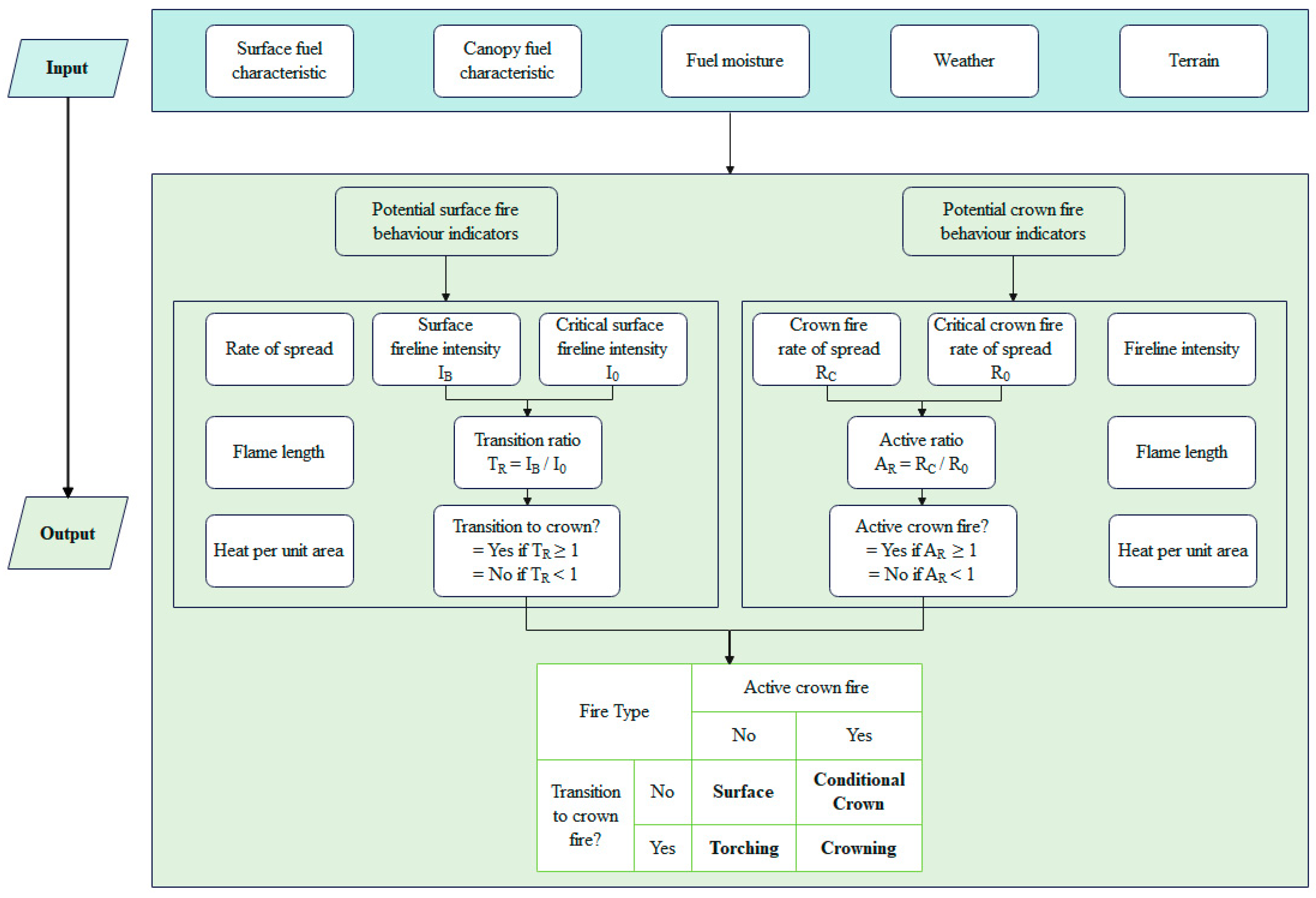
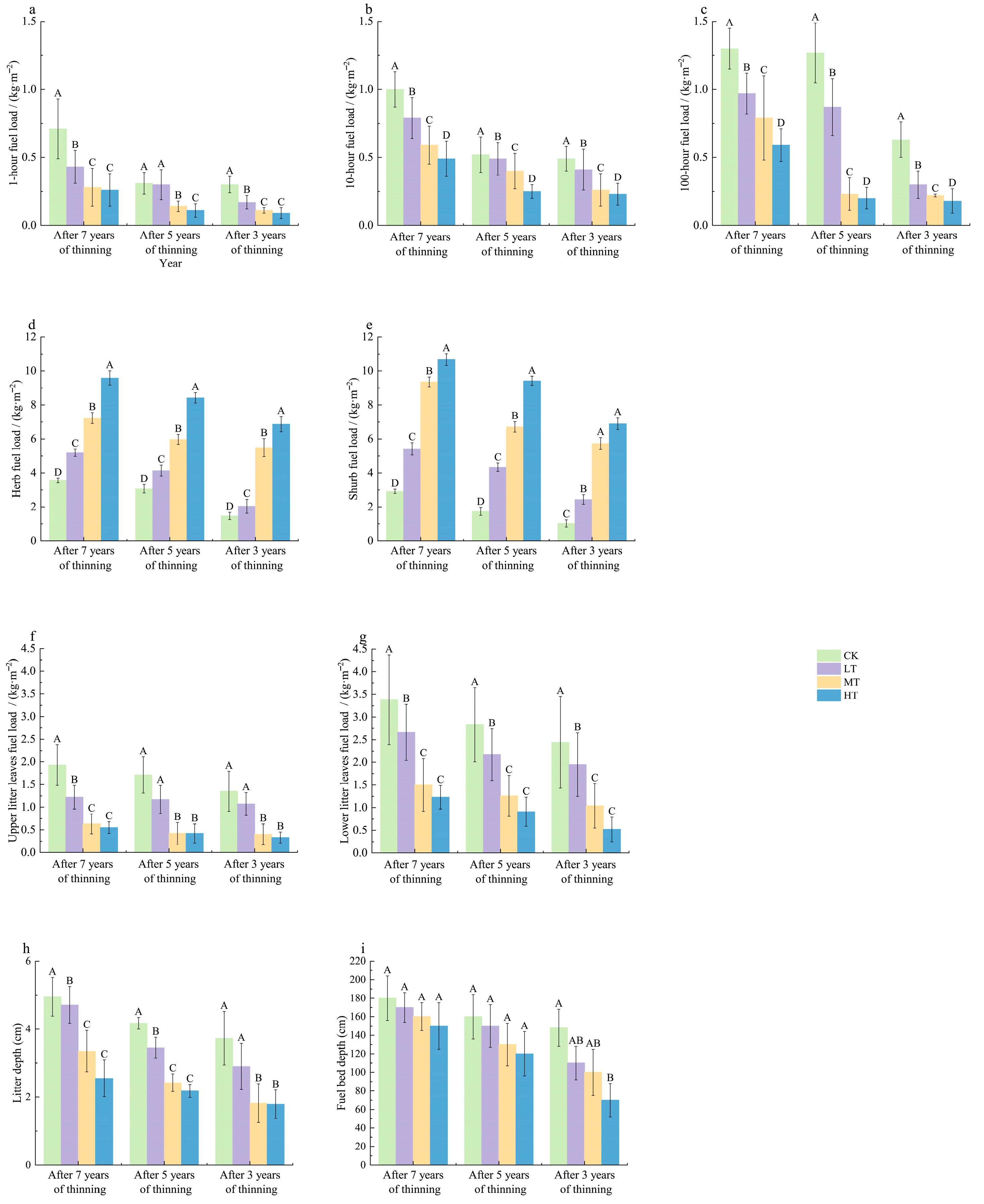
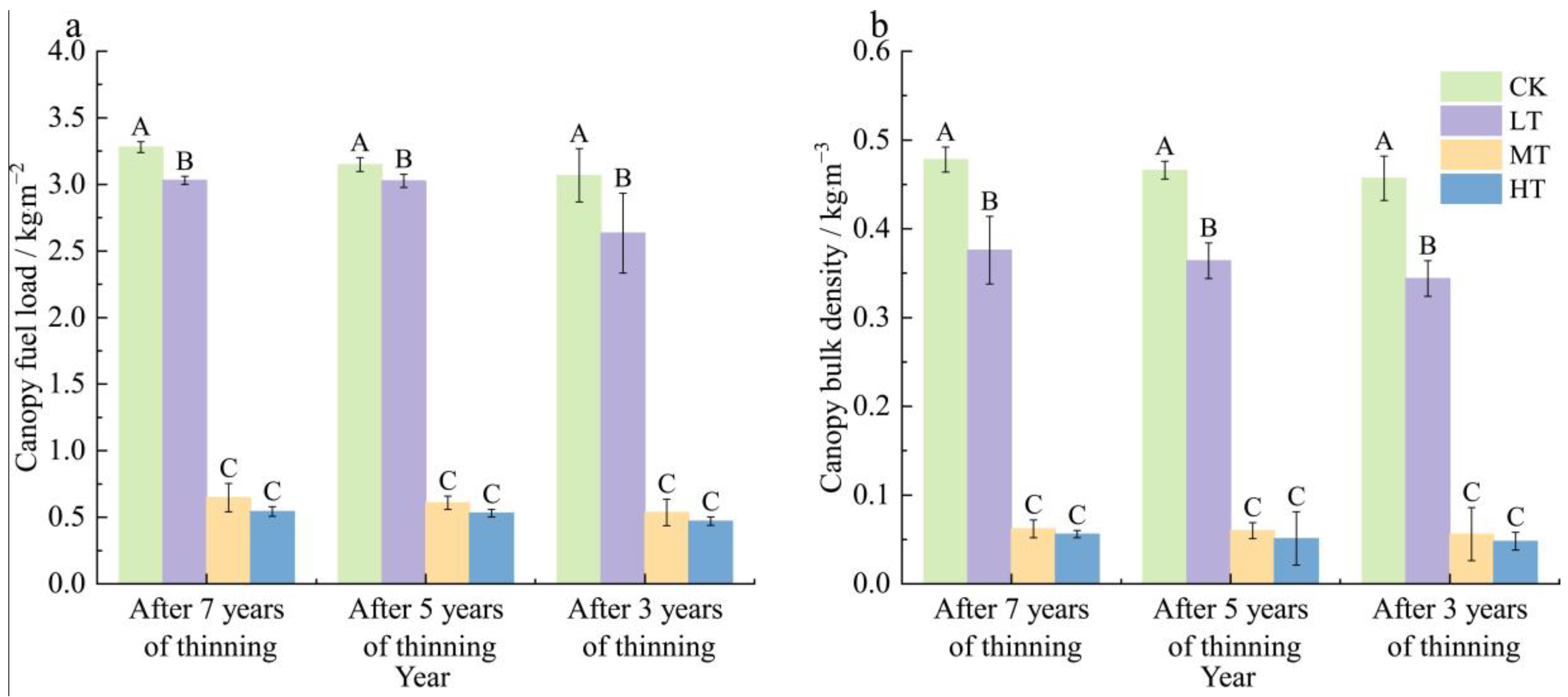
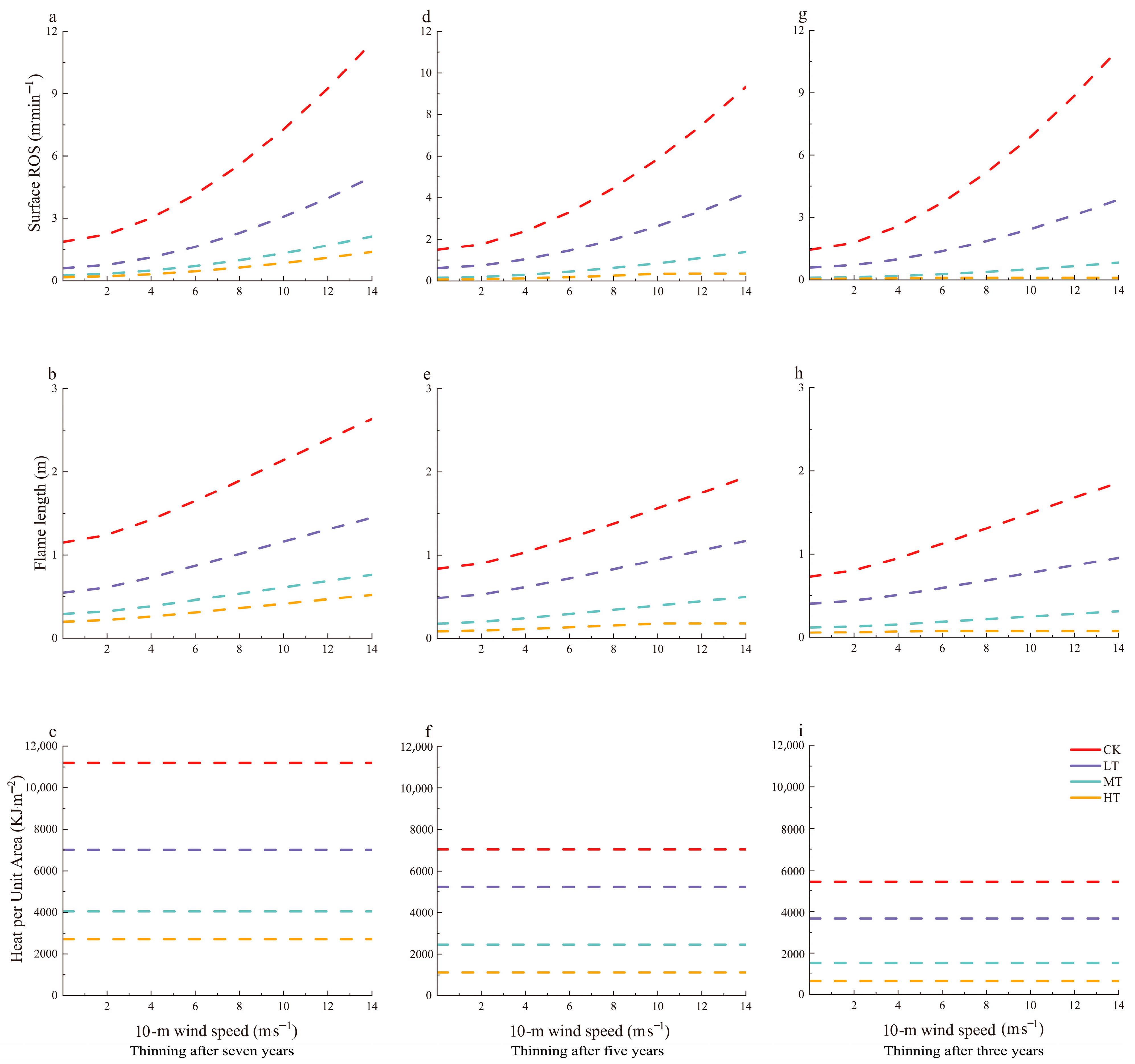

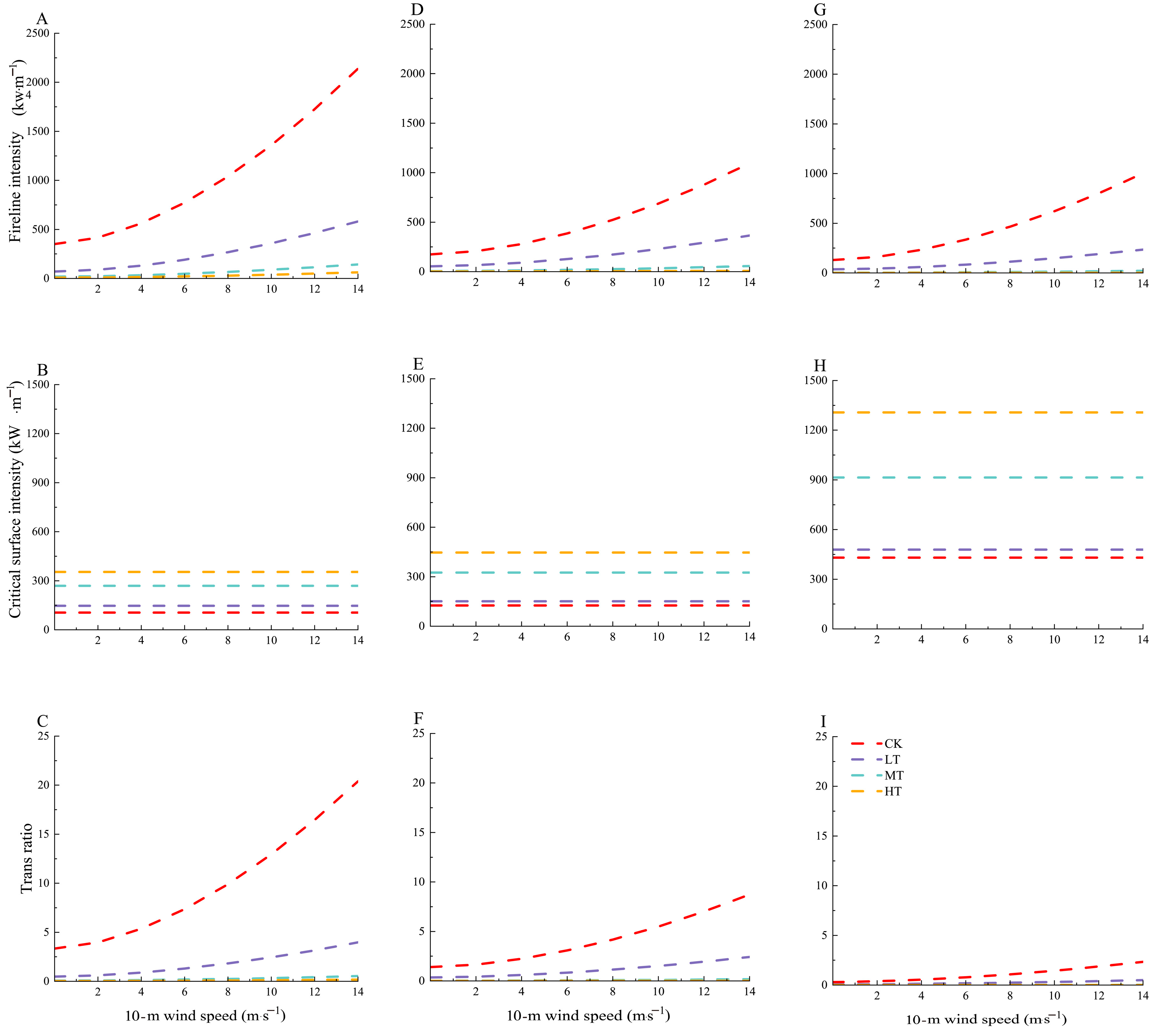
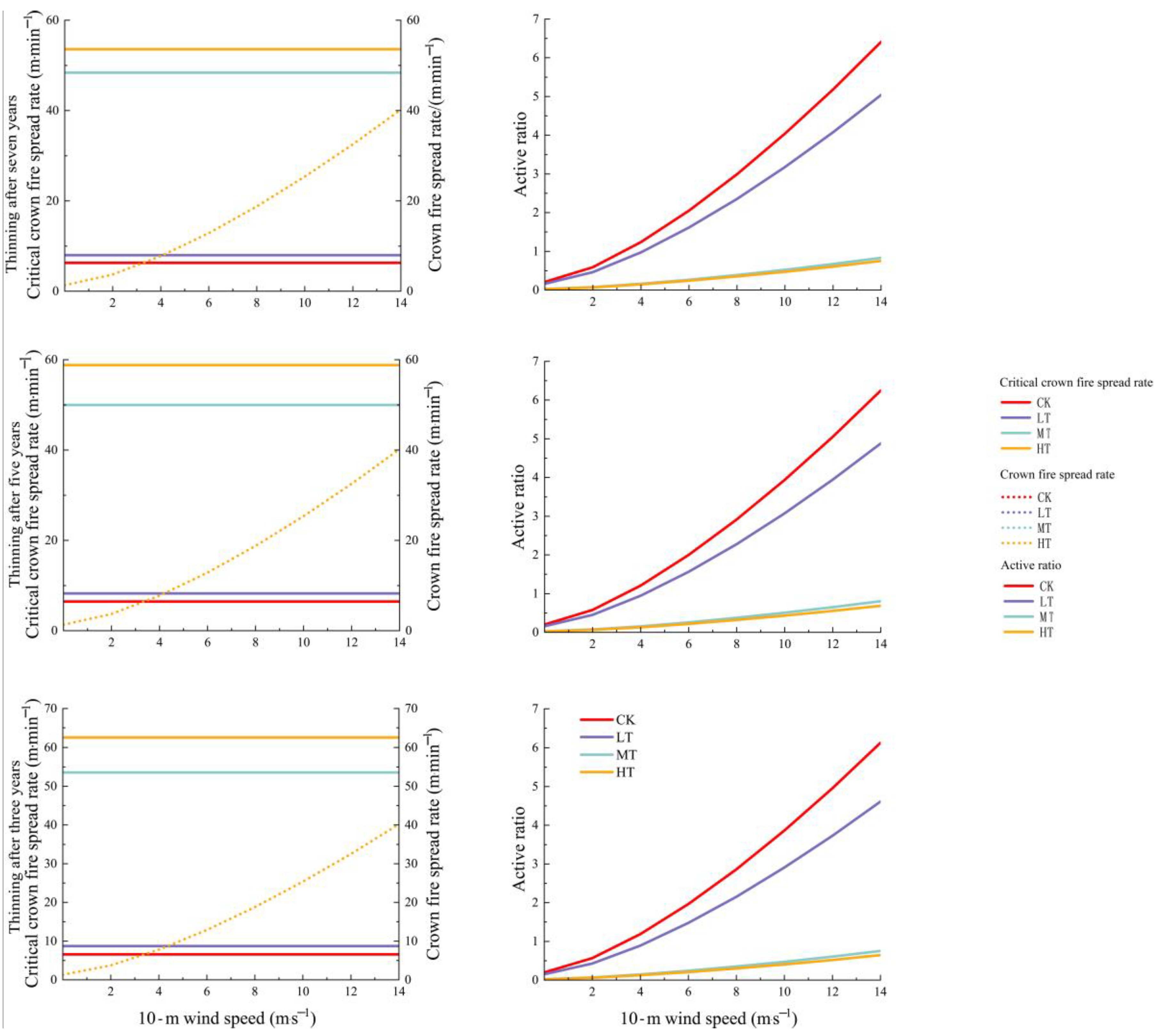
| Time after Thinning | Thinning Treatment | Density (Tree ha−1) | Canopy Cover | DBH (cm) | (m) | Tree Age (yr) | Elevation (m) | Slope (°) |
|---|---|---|---|---|---|---|---|---|
| 7 years | CK | 1863 | 0.75 | 13.80 | 10.1 | 53 | 439 | 25 |
| LT | 1565 | 0.70 | 14.37 | 11.81 | 53 | 268 | 20 | |
| MT | 1195 | 0.62 | 13.71 | 10.70 | 53 | 247 | 21 | |
| HT | 600 | 0.50 | 17.85 | 11.49 | 53 | 177 | 20 | |
| 5 years | CK | 1795 | 0.68 | 14.47 | 10.34 | 58 | 323 | 25 |
| LT | 1526 | 0.60 | 19.13 | 10.41 | 58 | 390 | 23 | |
| MT | 1167 | 0.55 | 17.72 | 10.82 | 58 | 390 | 18 | |
| HT | 898 | 0.40 | 22.10 | 11.04 | 58 | 374 | 20 | |
| 3 years | CK | 1800 | 0.70 | 14.97 | 9.25 | 48 | 391 | 22 |
| LT | 1527 | 0.60 | 13.71 | 10.21 | 48 | 376 | 24 | |
| MT | 1180 | 0.58 | 17.45 | 12.30 | 48 | 387 | 20 | |
| HT | 815 | 0.50 | 21.75 | 11.95 | 48 | 374 | 22 |
| Type | Category | Feature |
|---|---|---|
| Dead fuel | 1 h | d < 0.64 cm |
| 10 h | 0.64 cm < d < 2.54 cm | |
| 100 h | 2.54 cm < d < 7.62 cm | |
| 1000 h | d < 7.62 cm | |
| Upper layer leaves | Deciduous leaves within 1 year | |
| Lower layer leaves | Semi-decomposed fallen leaves | |
| Live fuel | Shrub | Various sizes depending on species |
| Herb | Various sizes depending on species |
| Time after Thinning | Branch Type | Estimation Parameter | R2adj | AIC | MSE | SEE | CF | |||||
|---|---|---|---|---|---|---|---|---|---|---|---|---|
| α0 | α1 | α2 | α3 | α4 | α5 | |||||||
| 7 years | Live branch | −0.578 | −0.567 | 0.950 | −0.837 | 2.511 | 0.168 | 0.839 | 197.374 | 0.200 | 0.448 | 1.105 |
| Dead branch | −4.608 | 0.938 | 0.473 | 0.872 | 1.347 | −0.932 | 0.932 | 228.627 | 0.132 | 0.364 | 1.068 | |
| 5 years | Live branch | −1.141 | 1.738 | −0.011 | −0.159 | 0.043 | −0.059 | 0.667 | 824.532 | 0.546 | 0.739 | 1.314 |
| Dead branch | −3.767 | 0.618 | 1.633 | 0.514 | 0.618 | −0.140 | 0.945 | 173.280 | 0.137 | 0.370 | 1.071 | |
| 3 years | Live branch | −4.390 | 0.580 | 1.355 | 0.816 | 0.763 | 0.358 | 0.774 | 640.398 | 0.344 | 0.586 | 1.187 |
| Dead branch | −1.610 | 1.119 | 0.691 | 0.168 | −0.029 | −0.057 | 0.946 | 98.357 | 0.117 | 0.342 | 1.060 | |
| Fire Type | 7 Years after Thinning | 5 Years after Thinning | 3 Years after Thinning | ||||||||||
|---|---|---|---|---|---|---|---|---|---|---|---|---|---|
| CK | LT | MT | HT | CK | LT | MT | HT | CK | LT | MT | HT | ||
| 10-m Wind Speed m/s | 0 | PCF | SF | SF | SF | PCF | SF | SF | SF | SF | SF | SF | SF |
| 2 | PCF | SF | SF | SF | PCF | SF | SF | SF | SF | SF | SF | SF | |
| 4 | ACF | SF | SF | SF | ACF | SF | SF | SF | CACF | SF | SF | SF | |
| 6 | ACF | ACF | SF | SF | ACF | CACF | SF | SF | CACF | CACF | SF | SF | |
| 8 | ACF | ACF | SF | SF | ACF | ACF | SF | SF | ACF | CACF | SF | SF | |
| 10 | ACF | ACF | SF | SF | ACF | ACF | SF | SF | ACF | CACF | SF | SF | |
| 12 | ACF | ACF | SF | SF | ACF | ACF | SF | SF | ACF | CACF | SF | SF | |
| 14 | ACF | ACF | SF | SF | ACF | ACF | SF | SF | ACF | CACF | SF | SF | |
| Time after Thinning | Thinning Intensities | Herbs | Shrubs | ||||||
|---|---|---|---|---|---|---|---|---|---|
| D’ | H | D | J | D’ | H | D | J | ||
| 7 years | CK | 1.669 ± 0.524 A | 0.741 ± 0.204 A | 0.438 ± 0.035 B | 0.273 ± 0.053 B | 0.835 ± 0.132 B | 0.972 ± 0.147 B | 0.523 ± 0.034 B | 0.409 ± 0.051 B |
| LT | 1.836 ± 0.472 A | 0.966 ± 0.027 A | 0.597 ± 0.074 B | 0.338 ± 0.037 B | 1.168 ± 0.178 AB | 1.241 ± 0.725 B | 0.586 ± 0.074 B | 0.415 ± 0.061 B | |
| MT | 2.170 ± 0.158 A | 1.347 ± 0.872 A | 2.153 ± 0.025 A | 0.440 ± 0.027 A | 2.003 ± 0.628 A | 2.078 ± 0.148 A | 0.640 ± 0.046 A | 0.736 ± 0.042 A | |
| HT | 2.003 ± 0.367 A | 1.173 ± 0.026 A | 0.655 ± 0.537 B | 0.425 ± 0.052 B | 1.335 ± 0.257 AB | 1.285 ± 0.039 B | 0.550 ± 0.043 B | 0.465 ± 0.073 B | |
| 5 years | CK | 1.335 ± 0.246 A | 0.492 ± 0.073 C | 0.267 ± 0.032 B | 0.198 ± 0.015 C | 0.668 ± 0.126 C | 0.886 ± 0.064 B | 0.487 ± 0.056 A | 0.230 ± 0.029 B |
| LT | 1.502 ± 0.312 A | 0.542 ± 0.193 C | 0.350 ± 0.036 B | 0.273 ± 0.061 C | 0.835 ± 0.172 BC | 0.895 ± 0.062 B | 0.528 ± 0.074 A | 0.236 ± 0.083 B | |
| MT | 1.836 ± 0.831 A | 1.108 ± 0.323 A | 0.551 ± 0.038 A | 0.382 ± 0.046 A | 1.335 ± 0.346 A | 1.075 ± 0.025 A | 0.550 ± 0.042 A | 0.428 ± 0.027 A | |
| HT | 1.168 ± 0.528 A | 0.884 ± 0.026 B | 0.513 ± 0.075 A | 0.336 ± 0.043 B | 1.001 ± 0.203 B | 1.002 ± 0.125 B | 0.539 ± 0.022 A | 0.310 ± 0.035 B | |
| 3 years | CK | 0.668 ± 0.126 B | 0.434 ± 0.031 B | 0.224 ± 0.043 C | 0.196 ± 0.037 C | 0.501 ± 0.083 C | 0.729 ± 0.062 A | 0.415 ± 0.043 A | 0.359 ± 0.028 A |
| LT | 1.335 ± 0.317 AB | 0.537 ± 0.022 B | 0.326 ± 0.028 BC | 0.240 ± 0.015 BC | 0.835 ± 0.254 BC | 0.822 ± 0.325 A | 0.510 ± 0.027 B | 0.369 ± 0.022 A | |
| MT | 1.669 ± 0.621 B | 0.673 ± 0.089 A | 0.549 ± 0.151 A | 0.346 ± 0.076 A | 1.335 ± 0.125 A | 1.008 ± 0.375 A | 0.710 ± 0.068 B | 0.401 ± 0.069 A | |
| HT | 1.168 ± 0.725 A | 0.583 ± 0.105 A | 0.448 ± 0.024 AB | 0.294 ± 0.025 AB | 1.001 ± 0.324 AB | 0.977 ± 0.056 A | 1.225 ± 0.219 B | 0.384 ± 0.059 A | |
| Thinning intensities | ns | *** | *** | *** | *** | *** | *** | *** | |
Disclaimer/Publisher’s Note: The statements, opinions and data contained in all publications are solely those of the individual author(s) and contributor(s) and not of MDPI and/or the editor(s). MDPI and/or the editor(s) disclaim responsibility for any injury to people or property resulting from any ideas, methods, instructions or products referred to in the content. |
© 2024 by the authors. Licensee MDPI, Basel, Switzerland. This article is an open access article distributed under the terms and conditions of the Creative Commons Attribution (CC BY) license (https://creativecommons.org/licenses/by/4.0/).
Share and Cite
Gao, M.; Chen, S.; Suo, A.; Chen, F.; Liu, X. Response of Fuel Characteristics, Potential Fire Behavior, and Understory Vegetation Diversity to Thinning in Platycladus orientalis Forest in Beijing, China. Forests 2024, 15, 1667. https://doi.org/10.3390/f15091667
Gao M, Chen S, Suo A, Chen F, Liu X. Response of Fuel Characteristics, Potential Fire Behavior, and Understory Vegetation Diversity to Thinning in Platycladus orientalis Forest in Beijing, China. Forests. 2024; 15(9):1667. https://doi.org/10.3390/f15091667
Chicago/Turabian StyleGao, Min, Sifan Chen, Aoli Suo, Feng Chen, and Xiaodong Liu. 2024. "Response of Fuel Characteristics, Potential Fire Behavior, and Understory Vegetation Diversity to Thinning in Platycladus orientalis Forest in Beijing, China" Forests 15, no. 9: 1667. https://doi.org/10.3390/f15091667






